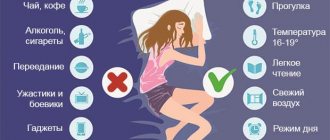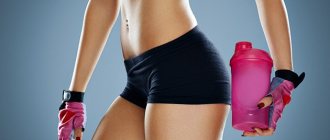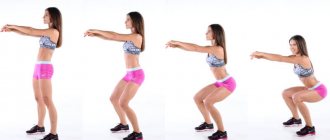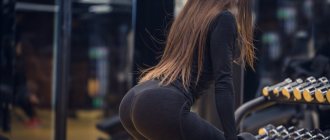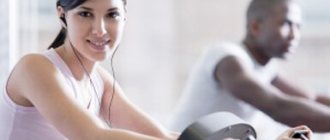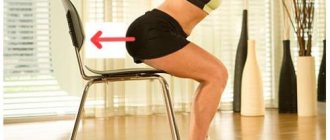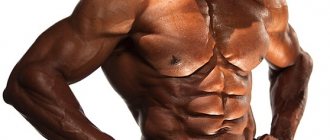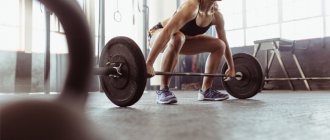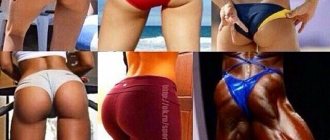To make the shape of the buttocks more distinct and create a beautiful arch in the lower back, you need to work the gluteus medius muscle. It works both when performing many different movements, such as running and walking, and maintaining a standing position.
With a sedentary lifestyle, the gluteus medius muscles can atrophy, which has negative consequences for the body. Therefore, exercises need to be included in any program, and in some cases, the lesson should be completely devoted to working it out.
How to make your butt big and pumped up
It is known that there is such an irresistible thing as hereditary predisposition. If a woman has a narrow pelvis, then training will not make it wider. And vice versa, if a man’s pelvis is wider than he would like, not a single gym will be able to narrow it. The shape of the butt depends mainly on the parameters of the gluteus maximus muscle, quite a bit - on the middle muscle, and practically does not depend on the gluteus minimus muscle. By the way, the length and width of the muscle cannot be changed either - genetics does not allow it. But you can pump up your butt and remove excess fat. That is, to a certain extent, increase muscle mass and “dry out” excess deposits. But everything is good in moderation: one admires elasticity, not thinness; Flabbiness is what disgusts, not fullness.
It is impossible to get an attractively shaped butt, although you can inherit it, but it won’t last long. The most reliable way is training. Moreover, to get a beautiful butt, experts advise pumping the upper, lower and lateral sectors of the buttocks separately. This allows you to form the surface with great precision, hide imperfections and bring the shape closer to the ideal. Next, we will look in detail at how to change specific areas of the buttocks.
Nutrition rules
Nutrition is a very important element in every training program. After grueling workouts in the gym, an athlete must eat quality food. At the initial level of training, you must determine the goal of your training.
Drying
If you have problems with cellulite on the buttocks, as well as with excess fat deposits on the sides (the so-called “breeches”), in addition to doing exercises, you should lose excess weight. To do this, you must consume fewer calories per day than you burn.
The amount of deficiency is no more than 15-20%, it is very important not to starve, because after intense training you need to provide the body with the necessary energy
For effective results, provide the body with a sufficient amount of protein (2 g per kg of weight) and complex carbohydrates (at least 1-1.5 g). Don’t completely eliminate fats; they are definitely needed, especially unsaturated ones. 0.8-1 g per kg of weight will be enough.
Mass recruitment
Those with flat buttocks, on the contrary, should take care of gaining weight. You need to burn fewer calories than you consume. The surplus should also be within 15-20% of the daily caloric intake. Eat a lot and often. The lion's share of the daily diet should consist of complex carbohydrates (pasta from durum wheat, rice, buckwheat, pearl barley). You also need protein, about 2 g per kg of body.
During mass gain, athletes often use various sports nutrition products. Protein and gainer will help you gain the right amount of calories if you find it difficult to eat a lot or don’t have enough time.
There are also generally accepted rules for quality nutrition:
- Drink plenty of water, at least 33 ml per kg of weight.
- Do not eat 1.5-2 hours before class. Otherwise, you may experience dizziness and nausea. Your pre-workout meal should consist of complex carbohydrates and proteins.
- Eat well immediately after class. Under no circumstances should you go hungry.
- In the evening, it is best to eat low-fat cottage cheese, providing the body with “slow” protein.
- After 18:00 you can and should eat, even on a diet.
Eat only quality food. Normalize your eating process. This way you can achieve results much faster.
How to pump up your upper buttocks
To obtain tangible results, discipline, adherence to a training regimen, and honest work with full dedication are of great importance. All this is achieved through motivation. It is recommended to conduct training three times a week, each session for about an hour. All the exercises below are performed in three sets, the number of repetitions should be gradually increased from 20 to 30 times.
Full squats with dumbbells are one of the best ways to pump up the upper buttocks, because the additional weight significantly improves the result.
So, holding dumbbells in your hands, stand straight with your feet 10 inches apart. Squat down gently, taking a deep breath, until the dumbbells touch the floor. The body should be slightly tilted forward, the back straight, the heel does not come off the floor. Without fixing yourself at the bottom point, rise vigorously, exhaling powerfully, and immediately begin squatting again.
| Recommended weight of dumbbells, kg | women | men |
| for beginners | 4–5 | 6–8 |
| further increase to | 10–15 | 16–32 |
The gluteal bridge is perfect for pumping up the upper part of the butt, and also develops the muscles of the back of the thighs and back extensors well.
Starting position - lying on your back, legs bent at the knees, place a barbell plate (or other additional weight) on your lower abdomen and hold it with your hands. As you exhale, lift your pelvis as high as you can, keep your back straight, resting on your shoulder blades and feet. Fix for a moment at the top, smoothly lower to the starting position, inhaling. Without pausing at the bottom point, immediately repeat the exercise.
Swing your leg back - in addition to pumping, it also stretches the gluteal muscles; the exercise strengthens and strengthens the muscles of the back of the thighs, promotes greater mobility of the hip joints.
Take an elastic band or expander and get on all fours, resting on your elbows and knees. Squeeze the ends of the elastic band in your hands, and secure the middle of the elastic band on the foot of your right foot. As you exhale, swing your right leg (without bending it) back and up, intensely straining your buttocks. Return your leg to the starting position while exhaling. After completing the required number of repetitions, strengthen the middle of the band on the foot of your left foot, and then repeat everything again.
Partial squat - this exercise helps to pump up the upper buttocks at home, although the skill itself can be useful in the office.
Place a chair behind you and begin to sit down, but touch the surface of it. The back should be straight, the buttocks tense, the distance to the chair should be minimal. When you reach the bottom, rise up. As soon as you find that you can maintain your balance without touching the chair, place a 3-5 cm thick stand under each sock. If you can squat stably without landing on the chair, then the preparatory part is complete. Then you can continue exercising without the safety net of a chair.
Exercises with a step platform
According to professional trainers, steps on the stairs are considered very effective for pumping up the gluteal muscles. For this reason, residents of high-rise buildings can be recommended to “travel” from the apartment on their business and back not by elevator, but on foot. It’s also great to have a special step platform in your home. It can be purchased at any specialized sporting goods store. There are a lot of exercises with this apparatus. However, the most effective, but also difficult, is considered to be jumping onto a stand from a saddle. To do it correctly, you must:
- Stand near the step platform with your feet shoulder-width apart.
- Clasp your hands at the elbows and bring them together in front of the chest, elbows pointing down.
- Bend your upper body forward so that your shoulders and knees are at the same level.
- Now we do a deep squat, trying to get our thighs parallel to the floor.
- We fix the position of the body. It should not change throughout the lesson.
- Then we make a dash and jump onto the step platform.
- Then we jump back. Keep your back straight and look ahead.
- Repeat 10 times.
If this exercise seems very difficult, at first you can do stepping onto the stand. It is not difficult to perform, and the video instructions presented below will help you verify this.
What does a pumped up gluteus medius muscle provide, and what exercises are there for its growth?
It’s a shame to disappoint that part of the audience who, in an effort to figure out how to pump up the upper butt, hopes that there are separate muscles for the upper and lower buttocks. Alas, there are no separate muscles, as well as the ability to tense a separate section of a muscle fiber in such a way that another part of the same muscle remains relaxed. So how to pump up a big butt and a narrow waist? To do this, you need to increase the volume of all gluteal muscles and actively work on your posture, in particular, do not forget about stretching the lumbar region. In the context of correct posture, pumped gluteal muscles look more advantageous.
Loading the gluteus medius muscle is necessary in order to pump up the hollows of the buttocks, in other words, to pump up the side of the buttocks. This is achieved by performing the following exercises:
- walking on the buttocks - legs extended forward are positioned horizontally, back straight - vertically;
- swing your leg to the side from a lying position;
- gluteal bridge with fixation at the top point for 15–20 seconds;
- pulling your feet towards your buttocks while lying on your stomach.
But to get a big round butt, you need to use the gluteus minimus muscle. In many complexes it works together with other muscles of this group, and yet some exercises create a separate emphasis on the gluteus minimus muscle:
- moving the leg bent at the knee to the side from a standing position on all fours;
- abduction of the straight leg, held by the expander, to the side from a standing position;
- leg extensions in the simulator;
- plie squats with a dumbbell.
Everything has its price, including every action and inaction leads to predictable consequences. So, for example, if you work out hard in the gym (we recommend the sports club in Zyablikovo) and, having already achieved noticeable results, decide that this is enough, the same predicted consequences will occur. A subgluteal fold will appear. Moreover, the more advantageous the genetic predisposition to a beautiful butt shape and the more impressive the successes in enlarging the buttocks through training, the more clearly the annoying crease will stand out. The question of how to pump up the lower part of the butt now is not entirely correct. But, read on.
Muscular structure of the thigh
The anatomy of the hip provides the muscular structure as a powerful element, since they also perform upright posture.
The muscle tissues of this area are long, some reach the area of the feet, which means they somehow affect the function of the entire limb. The layered structure of the human thigh is represented by the following classes:
- front;
- rear;
- medial.
Moreover, the division is not arbitrary - the anterior and posterior classes, or groups, are separated vertically by an intermuscular septum.
Front
This class of muscle elements includes those called extensors, that is, they perform the function of extension. The anterior thigh muscle group includes 2 elements - the quadriceps and the portius muscles.
The quadriceps is a large element that fills the anterolateral region of the femoral area of the limb, connects four grouped muscle branches (heads):
- straight;
- lateral;
- medial;
- vastus intermedius.
Action: ankle extensor.
The tailbone, starting in the lumbar area, is combined with the tibia. Allows you to bend the knee, and already in this position allows you to rotate the ankle inward.
Posterior muscles
The hamstring muscles are part of the class that help in flexing the limb. The flexor block consists of the following muscles:
- Semitendinosus muscle. From the ischium it is combined with the posterior fascia.
- Semi-membranous. Under the semitendinosus, at the condyle of the femur, it connects with the semimembranosus tendon.
- Double-headed. It is located on the outer side of the femur, has 2 heads - one at the ischial tuberosity, the other at the lateral lip, tending to the fibula.
- Popliteal. It is formed in the middle of the femur, connects to the knee joint and comes to the posterior surface of the ankle.
4 muscles, since they run along the hip and knee joints, help straighten in one zone and bend in another.
The semitendinosus and semimembranosus muscles are located on the outer side of the thigh, the biceps and popliteus are somewhat removed inward.
Domestic
The inner thigh muscles, or medialis, make up the adductor unit - allowing the hip region to move inward from a resting position and from an abducted position.
The internal class consists of the following muscle elements:
- Comb. It arises from the pubic branch and attaches diagonally to the femur.
- Long adductor. It starts from the anterior region of the pubic ramus and connects to the femur just below the pectineus.
- Short adductor. It lies under the pectineus and adductor.
- Greater adductor. Distributes from the symphysis pubis to the condyle of the femur.
- Thin. It originates at the pubic joint and ends at the fascia of the ankle.
In addition to the adducting action, they can assist in extension and flexion.
How to tighten your lower buttocks
Muscles need tone, otherwise, when the load decreases, they become flabby and begin to sag. The reason for this may be not only the cessation of training that has already become habitual, but also the emergence of bad habits, a predominantly sedentary lifestyle, and a sharp change in weight.
How to tighten your butt from below? In short, by eliminating the causes of sagging soft tissues:
- remove excess fat;
- move more;
- leave bad habits;
- restore training.
These measures are usually sufficient. However, if you urgently need to tighten the bottom of your buttocks, then we recommend using strength exercises and specific walking:
- deep lunges with dumbbells - keep your back vertical;
- squats with dumbbells with legs wide apart;
- deadlift with dumbbells;
- walking uphill.
The last of the proposed exercises is best performed on a treadmill or on an ellipsoid, setting the inclination angle to at least 9–12%. The weight of dumbbells, the number of repetitions and approaches are indicated in the table at the beginning of the article. As you can see, making your butt big and pumped up is a doable task, and you can handle it.
Why is strengthening Gluteus Medius so important?
This muscle is often forgotten. More precisely, it needs to be trained and pumped up. Especially girls who do butt exercises mainly to improve their shape.
Gluteus Medius is located under the large muscle. And it doesn’t seem to have that much effect on the shape of the butt.
This is a misleading impression. The muscle has a big influence on how the back of a person's body looks below the back. But more importantly, the gluteus medius is responsible for many pelvic and back functions. That is, its condition directly affects the health of the musculoskeletal system and the entire body as a whole.
A well-pumped middle muscle takes on most of the effort when lifting weights and many other complex body movements. But if it is poorly developed, then all efforts fall on the back, on the spine. Which has an extremely negative effect on his condition.
Calculate your ideal sports weight!
This muscle also provides outward rotation of the hip and is responsible for stable walking. With its injuries and pathologies, a person’s gait becomes unnatural – like a cat’s.
Do you need a warm-up?
Warm-up cannot be neglected. It will help make your workout more effective. What are the benefits of warming up:
- muscles and ligaments are warmed up, which reduces the risk of injury;
- warmed muscles cope better with loads;
- blood circulation throughout the body improves;
- hormones are released that produce energy;
- attentiveness and coordination improves.
If you neglect the warm-up complex, there is a high probability of developing a muscle strain or other injury.
Useful tips
You won't be able to pump up your buttocks in one day. It actually takes a lot of hard work and dedication to achieve that round shape you're looking for, and you need to structure your workouts clearly and effectively.
Luckily, you don't have to guess anymore about what makes a big butt. We've rounded up some of our best, most useful butt-building tips. All of them come from trainers and experts who know a thing or two about strengthening the lower body.
Read: Exercises to reduce the size of the thighs and buttocks
Lift heavy weights
While it may be tempting to stick with strength training that focuses on moving your own body weight, experts say it's better to lift heavier weights if you want a bigger butt. Muscle growth occurs when you tense your muscles. Therefore, if the goal is to make the butt grow, it is necessary to strain it with resistance with a more complex weight than it was before.
This means you have to lift a barbell, dumbbells, or kettlebell to see results. As your body adjusts, be sure to continue to include your glutes in your workouts by adding weight, increasing the overall load, or increasing the number of sessions relative to what you're training with.
Try to do one or two lower body workouts every week. Choose primarily strength exercises that focus on your lower body.
The main exercises for growing the buttocks are all kinds of lunges and squats. Choose heavy basic exercises with the correct movement technique. These exercises require the hip joints to work through basic movement and loading. Try to move your pelvis back as far as possible. The knee joint, in this case, is in one position. Don't bring your knees forward. Leg presses with an emphasis on the heels and all kinds of bridges with weights are also good.
Focus on sprinting rather than long distances
The glutes are the most important muscle group for proper running. Sprinters require a huge amount of glute strength to finish short distances, so doing power interval runs rather than long runs can help you build up your butt even more, especially if you do it in combination with strength training. Focus on running powerfully uphill with short intervals and good rest.
Eat more food! Diet.
To actually gain muscle mass and get a bigger butt, you need to fuel your body with the right amount of food. First of all, through daily protein intake. The general rule is to eat at least 1 to 1.5 grams per kilogram of body weight per day.
If you don't add all this extra food into your diet, you won't see the results you expect. So stick to whole, simple foods, and don't be afraid to eat!
Common mistakes
Those who are just starting to correct the shape of their buttocks often make a number of mistakes that prevent them from achieving results. What not to do:
- Focus on one exercise. It is believed that squats are the most effective form, but when performed, only one muscle group works, while you need to pump up everything.
- On the day when the training plan includes exercises for the legs and buttocks, start working with the legs. If the main goal is beautiful buttocks, initially perform exercises on them.
- Skip workouts or do them only once a week. There will be no effect, it is better to train every other day.
- Refuse the services of a trainer or perform exercises without following the instructions. You may not only not see changes, but also get injured.
